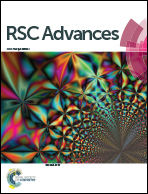Microwave assisted robust aqueous synthesis of Mn2+-doped CdSe QDs with enhanced electronic properties†
Abstract
A robust doping strategy of Mn2+ ions in CdSe QDs has been developed in aqueous medium with mild microwave irradiation using the short-chain capping ligand 3-MPA. The concentration of the dopant is varied stoichiometrically in order to measure its effect on the conductivity of QD solids for further potential applications in the future. The synthesis parameters of CdSe QDs have been optimized to produce a uniform size among various samples to decouple the doping dependent conductivity from their bandgap. Doping yield is measured extensively by several studies like EDS, ICP-AES, and XPS. The layer-by-layer electrostatic assembly method has been exploited to fabricate thin film devices. I–V characteristics reveal that the electrical conductivity of 2% Mn2+-doped CdSe QD devices is enhanced on the order of ∼104 compared to its undoped counterpart. The “auto-ionization” of Mn2+ dopants in CdSe QDs due to the quantum confinement effect is one reason for this jump in conductivity as described in the Poole–Frenkel effect. STM measurements of the monolayer QD device shows its resistive switching properties. Importantly, the threshold voltage of switching decreased with the increase of doping concentration. All these results confirm the efficiency of Mn2+ doping in zinc-blende CdSe QDs in aqueous medium, by avoiding the “self-purification” effect of CdSe QDs, and their further application as a potential candidate for future memristor devices.



 Please wait while we load your content...
Please wait while we load your content...